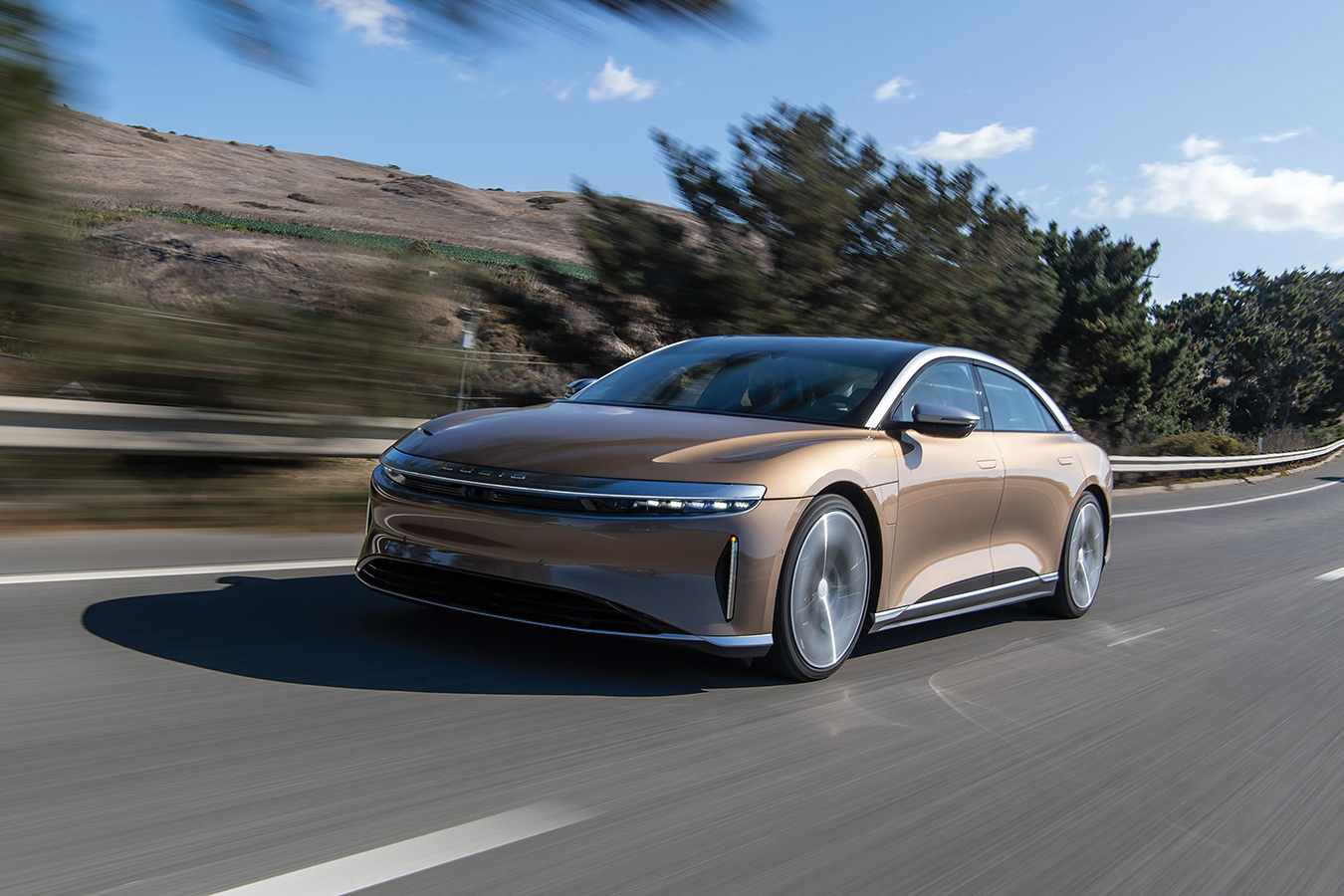Tape measure in hand, Lucid CEO Peter Rawlinson is in the driver’s-side footwell of his company’s Air Dream, measuring the distance from the brake pedal to the rear seatback. It’s a nontraditional dimension that Rawlinson, a former Lotus and Tesla engineer, uses to assess interior space, and he’s out to prove that his company’s new electric car hit one of its targets. The design of Lucid’s first car, which is now just reaching customers, is born of two goals he set: It should have the interior space of the Mercedes-Benz S-class, and it should handle like a Lotus. The metal tape crackles as it bends through the cabin, and we get the number: 83.1 inches, a few more than what he measured in the S-class.
We’ve now driven the 1111-hp Air Dream P (the P is for Performance). At an estimated 5200 pounds, it’ll never shuffle-step like a Lotus, but the Air steers with soul. The feedback flowing into your hands makes it possible to detect change in pavement types.
The chassis, not exactly groundbreaking, features a multilink setup with coil springs, adaptive dampers, and anti-roll bars in front and back. With no air springs, active anti-roll bars, or rear-wheel steering, the Air feels natural and predictable unraveling corners. Driving it quickly is certainly easy, as is probing the high limits of the tailor-made Pirelli P Zero PZ4 Elect tires. The three-position dampers never introduce harshness, even in their most aggressive setting.
The low center of gravity, a byproduct of the battery pack in the floor that boosts the aluminum structure’s rigidity, helps keep body motions in check. The Air might not have the unfiltered flavor of a Lotus, but for a heavy car with a supple ride, it is connected and secure on a fun road.
Rawlinson’s goals didn’t mention Bugatti-grade acceleration, but it’s there. Select Sprint mode to unlock the two motors’ combined 1111-hp capability (they’re limited to 784 otherwise) and the acceleration is so hard that it leaves your inner ear a little punch-drunk. A mere squirt of the accelerator brings triple-digit speeds. We’d estimate a 60-mph time in the mid-two-second range with the quarter-mile potentially cracking 10 seconds. Top speed is governed to 168 mph.
Careful tuning of the aerodynamics results in a low 0.20 coefficient of drag. At highway speeds, an audible rush of air passes over the A-pillars. While the sound isn’t intrusive, the Lucid isn’t quite as silent to the ear as Mercedes-Benz’s EQS electric, which claims to be just as slippery.
Lucid didn’t add artificial sound to the car, so what you hear under acceleration is actual motor whine. The radial-flux front and rear motors are identical, and each weighs a mere 163 pounds. They’re a big part of how Lucid managed to get S-class space into a car with a 116.5-inch wheelbase—10.1 inches shorter than the S-class—and a 195.9-inch length.
Inside is an attractive mix of leather, Alcantara, and an alpaca blend. Interior fits are good, although the small tumblers on the steering wheel for the audio system and adaptive cruise had a crunchiness that Lucid promises to fix before sales start.
Each of the 22 battery modules has 5.4 kilowatt-hours and weighs 51.8 pounds, or 9.7 pounds per kilowatt-hour. The Air Dream’s battery has a 118.0-kWh capacity, while lesser models get a 112.0-kWh pack. The battery pack’s lid flows coolant over top of the cells. Lucid engineers claim their solution chills better than Tesla’s.
While the Air Dream Range model on 19-inch wheels has 520 miles of EPA range, the Air Dream P on 21s does 451 miles. Recharging on a 300-kW DC connection can take the battery from 10 to 80 percent in 20 minutes. The 19.2-kW onboard charger should replenish the battery in less than seven hours, so long as the electricity feeding it is powerful enough.
It all seems too good to be true. An 1111-hp EV with class-leading range and loads of clever solutions and tech as a first car? When customers who plunked down their $170,500 start racking up real-world miles, we’ll know whether this tenacious company, which nearly went bankrupt pursuing the Dream, will succeed. If what we saw and drove translates to reality, we’d say it won’t vanish into thin air.







